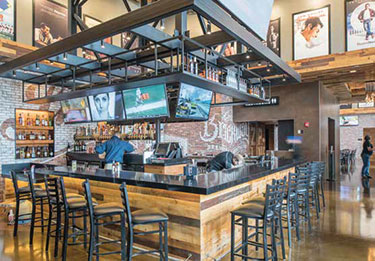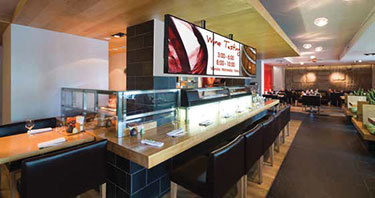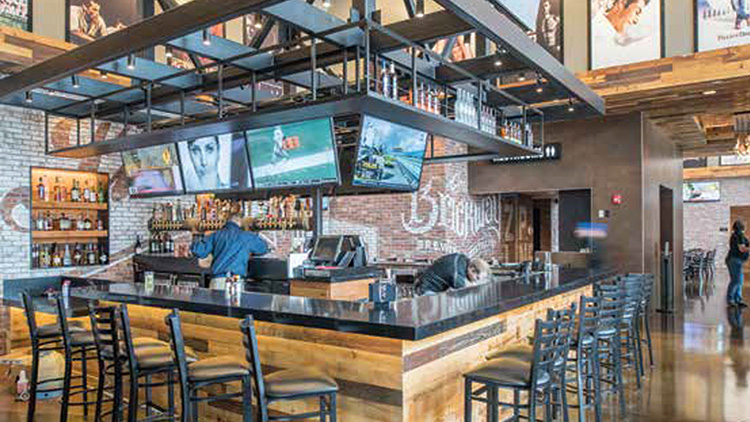If you are what you eat, as the saying goes, it follows that you are what you watch and hear before and during a restaurant meal. Creating experiences in hospitality, particularly in the high-pressure realm of restaurant operations, is salient to attracting and retaining a customer base.
And in order to be successful in this highly competitive restaurant landscape, owners must consider customer-based innovations to increase the attraction level of their restaurant experience, said Brian McClimans, vice president of global business development, Peerless-AV.
“This is being done through the use of digital entertainment, digital experiential offers, in addition to loyalty programs and special offers,” he said. “Such things as interactive trivia games, to VR devices, to special text-based offers have proven to help improve the experience and overall value.”
See the Sign

The Alamo Drafthouse cinema chain’s new venue in Omaha opened with an immersive, multi-zoned dining and entertainment experience that features an audio system processed by a QSC Q-SYS Core 250i and powered by CXD4.3Q four-channel networked configurable amplifiers. The entire Q-SYS system is easily monitored and controlled on an iPad via Q-SYS UCI Viewer for iOS. Digital signage displays give customers something more interesting to look at than the head of the person in front of them, noted Garry Wicka, head of marketing, LG Electronics Business Solutions. “The more interesting, relevant, and engaging your content, the more effectively it works. This is one reason that we hear that restaurateurs often prefer digital signage that is engaging from every angle, much like what you get when using LG’s IPS displays. Digital signage can also provide a new way to interact with the restaurants themselves—ordering kiosks, entertainment content, and, of course, a better way to highlight the products themselves.”
And what are hospitality clients asking for? The biggest movement in the hospitality industry is the need for higher quality, better resolution, and of course, larger sizes, Wicka said. “A larger screen with a higher resolution is going to capture guests’ attention a lot more than the older, smaller models. In addition, we have had a lot of customers starting to ask about the LG OLED signage models that were launched this year.”
With restaurants consistently looking for new ways of engaging patrons, Peerless-AV has been noticing a rise in entertainment venues expanding their focus on food, to create both an interactive experience as well as a restaurant experience. Examples can be seen with Lucky Strike, Level257 (local IL location), and Top Golf, McClimans said. “These venues have created numerous opportunities for digital signage in the food space such as digital menu boards and self ordering kiosks, etc., as well as entertainment such as TVs showing sports, interactive kiosks, and wayfinding, etc. These models have been proving to be quite successful.”
The huge uptick in digital menu boards over the past few years is now extending to the outdoor space, specifically in drive-throughs, Wicka noted. “In addition, we are starting to see other sizes of displays start to make a foothold in several areas. LG’s 10-inch and 22-inch displays can fit the many needs of quick-service restaurants and of course, models that present unique formats like LG’s 86-inch stretch are used to grab customers’ attention.”
He also anticipates that more and more, displays are going to be seen as a part of the design of the facilities, rather than an afterthought. “This means you will see more types of displays that can potentially be placed throughout a restaurant.”
Now Hear This

Peerless-AV has noticed how opportunities for digital signage in restaurants have expanded with digital menu boards and self ordering kiosks. QSC has seen opportunities in chain restaurants and restaurants that are part of larger venues, said David Fuller, senior director, product development, loudspeakers, QSC. “The more QSC becomes involved in the facility-wide audio solution, (messaging, paging, touchscreen controllers, amplifiers, and distributed loudspeakers, etc.) the more likely it is that ancillary zones such as bars and restaurants are integrated into the wider system, with the added benefit of centralized control and monitoring.” Restaurants, cafes, and especially bars demand high-quality amplifier and loudspeaker products more than corporate and education markets, where amplifiers and loudspeaker are of much lower dollar value than the audio DSP and video control products, he added. “One of our more successful products in this space is actually our Q-SYS wall-mount touchscreen controllers, the TSC-3 and TSC-7w. Connected to a Q-SYS Core110f, restaurants can use the controller for facility-wide zoned source selection and volume.”
Employing AV technology to reach customers before they come into a restaurant represents an “anything goes” environment, Fuller said. “There’s lots of room. Enticing patrons walking past the entrance or patio requires outdoor loudspeakers with a high degree of weather resistance to maintain an attractive look. While boasting a very impressive IP-54 rating, QSC’s secondgeneration AcousticDesign Series family of surface loudspeakers actually go beyond IP ratings to include powder-coated aluminum wall brackets, powder-coated aluminum grilles, durable nylon mesh grille backing, and even include a sealed input cover.”
More Food, Please
As the restaurant market, including dedicated eateries, grows, so do the opportunities. “LG has been very focused on helping our customers provide a better customer experience through digital signage, and with the new models like the 86-inch stretch and the new commercial OLED signage products, I would expect to see this vertical continue to grow for us,” Wicka said.
This market also is growing for Peerless-AV, McClimans said. “Many restaurants are incorporating digital menu boards and digital entertainment, like Buffalo Wild Wings, which has trivia playing on TVs throughout the restaurant, or Chili’s, which outfits each table with a desktop tablet setup that offers games for its patrons along with the standard restaurant services. We provide solutions including mounts, displays, and stands to support these uses.
“For our QSR customers in particular, the government regulations surrounding the addition of nutritional info to menus has been supported through our digital menu boards,” he added. “Restaurants are able to offer this information in engaging and easy-to-read ways, both indoors and outside.”
Karen Mitchell is a freelance writer based in Boulder, CO.
